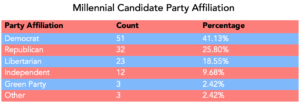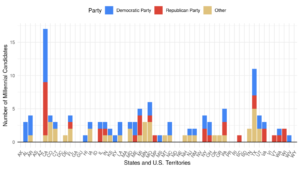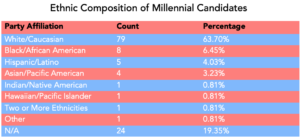Candidates for Congress 2018
Demographic Facts for the United States
According to the numbers of the United States Census Bureau from 2010, the largest generation in the U.S. is the Boomer Generation (25%).1,2 With 22.2%, the second largest generation is the Millennial Generation. About 21% of the U.S. population belong to Generation X. The smallest generation is the Silent Generation with 11.3%.
In 2018, 50.8% of the American population was female.3 About 60% of the population was White, 13.4% Black/African American, and 18.1% Latino/Hispanic. Almost 6% were Asian American, and 1.3% American Indian/Alaska Native. About 0.2% were Native Hawaiian/Pacific Islanders. There were almost 3% that belong to two or more categories.
About the 2018 Midterm Elections
On November 6, 2018, 468 seats in Congress were up for election: 33 seats in the Senate and all 435 seats in the House of Representatives.¹ Following the primaries, 1370 candidates ran for the general election. Of these candidates, 479 ran as Democrats and 453 as Republicans. Almost 440 ran as third-party candidates or Independents.
Generational Composition of the Candidate Pool
Of the data available on candidates, 9% (124) were Millennials.2 Of these Millennials, 72% were 35 years of age or younger. Thirty-seven percent of the candidates were Baby Boomers, 26% were from Generation X, and 5% were from the Silent Generation. Of these 124 Millennials, only 8 ran for the Senate and the remaining for the U.S. House of Representatives.
Partisanship of Millennial Candidates
Most Millennial candidates were Democrats (41.1%), followed by Republicans (25.8%). Almost 34% of all Millennial candidates ran for other parties.

Millennial Candidates for Congress 2018 by State and Party

Gender Composition of Millennial Candidates
Of the Millennials running for Congress, 26.6% were women and 73% were men. When we focus only on those Millennials 35 years or younger, a smaller percentage (20.3%) are women and 79.8% are men. It is worth noting that all 8 Millennial candidates for the U.S. Senate were men.
Ethnic Composition of Millennial Candidates
Regarding the ethnic and racial background of Millennial candidates, most were White followed by African American and Hispanic/Latino.

Differences Between States

Notes
- Information on candidates from Ballotpedia.org.
- The Young Elected Leaders Project collects and analyzes data on young politicians across the country. We define Young Candidates as candidates 35 years and younger. We define the generations following the Pew Research Center:
- Millennial Generation: 1981-1996 (age 22-37)
- Generation X: 1965-1980 (age 38-53)
- Baby Boom Generation: 1946-1964 (age 54-72)
- Silent Generation: 1928-1945 (age 73-90)

